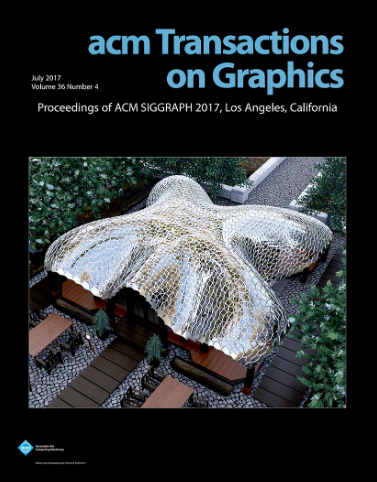当高斯遇到冲浪:超快速高保真亮度场渲染
IF 9.5
1区 计算机科学
Q1 COMPUTER SCIENCE, SOFTWARE ENGINEERING
引用次数: 0
摘要
我们引入了高斯增强冲浪图(GESs),这是一种用于亮度场渲染的双尺度表示,其中一组具有视图相关颜色的2D不透明冲浪图代表了场景的粗尺度几何和外观,而冲浪图周围的一些3D高斯图补充了细尺度外观细节。GESs的绘制包括两个步骤,首先通过标准图形管道对图像进行栅格化,生成深度和颜色图,然后在每个像素顺序上独立进行深度测试和颜色积累的高斯图像飞溅。多视点图像的GESs优化是通过一个精细的从粗到精的过程来完成的,忠实地捕捉了丰富的场景外观。GESs的完全无排序渲染不仅实现了非常快的速度,而且还产生了与视图一致的图像,成功地避免了视图变化时弹出的伪影。基本的GES表示可以很容易地扩展以实现渲染中的抗锯齿(Mip-GES),提高渲染速度(speed -GES)和紧凑存储(compact -GES),并通过用2D高斯(2D-GES)替换3D高斯来重建更好的场景几何形状。实验结果表明,GESs作为超高速高保真度光场渲染的一种令人信服的表现方式,推进了目前最先进的技术。本文章由计算机程序翻译,如有差异,请以英文原文为准。
When Gaussian Meets Surfel: Ultra-fast High-fidelity Radiance Field Rendering
We introduce Gaussian-enhanced Surfels (GESs), a bi-scale representation for radiance field rendering, wherein a set of 2D opaque surfels with view-dependent colors represent the coarse-scale geometry and appearance of scenes, and a few 3D Gaussians surrounding the surfels supplement fine-scale appearance details. The rendering with GESs consists of two passes - surfels are first rasterized through a standard graphics pipeline to produce depth and color maps, and then Gaussians are splatted with depth testing and color accumulation on each pixel order independently. The optimization of GESs from multi-view images is performed through an elaborate coarse-to-fine procedure, faithfully capturing rich scene appearance. The entirely sorting-free rendering of GESs not only achieves very fast rates, but also produces view-consistent images, successfully avoiding popping artifacts under view changes. The basic GES representation can be easily extended to achieve antialiasing in rendering (Mip-GES), boosted rendering speeds (Speedy-GES) and compact storage (Compact-GES), and reconstruct better scene geometries by replacing 3D Gaussians with 2D Gaussians (2D-GES). Experimental results show that GESs advance the state-of-the-arts as a compelling representation for ultra-fast high-fidelity radiance field rendering.
求助全文
通过发布文献求助,成功后即可免费获取论文全文。
去求助
来源期刊

ACM Transactions on Graphics
工程技术-计算机:软件工程
CiteScore
14.30
自引率
25.80%
发文量
193
审稿时长
12 months
期刊介绍:
ACM Transactions on Graphics (TOG) is a peer-reviewed scientific journal that aims to disseminate the latest findings of note in the field of computer graphics. It has been published since 1982 by the Association for Computing Machinery. Starting in 2003, all papers accepted for presentation at the annual SIGGRAPH conference are printed in a special summer issue of the journal.
 求助内容:
求助内容: 应助结果提醒方式:
应助结果提醒方式:


